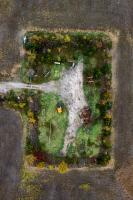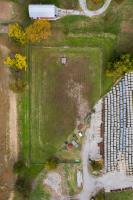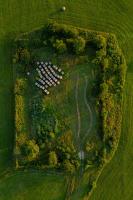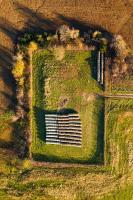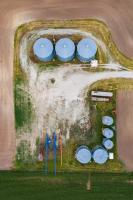Nate Hofer is a design director for a creative digital agency and grew up locally during the Cold War era. Inspired by his experiences as a child and by more recent international relations, Nate utilizes aerial photography to explore his fears and hopes for the future of the world.
Tell us about the works on exhibit. What has inspired their creation?
These are present day aerial photographs from the 150 decommissioned nuclear missile sites in western Missouri on alert during the Cold War from the 1960s to the 1990s. Originally they each had a nuclear intercontinental ballistic missile (or ICBM) ready at a moment’s notice to fire off in response to whatever and ultimately end our species’ global existence. Each of these one-and-a-half to two-acre lots were all located on farmland often near small rural towns. But after the Cold War ended and the sites were all destroyed by arms reduction treaties, the lots were sold back to the landowners and all of the parts were taken out or destroyed, except for the security fences. Today, in most cases, each of these sites are still very easy to identify if you know where to look.
Although they tell a story of Missouri’s role in the Cold War, these sites aren’t really only about the history to me, rather, they’re a reminder for our collective future that we today still have nuclear weapons in missile silos and submarines and jets and now other existential dilemmas to address: climate and misinformation. And so what are we gonna do about all of this? It can seem bleak, but I’m an optimistic person, and I have to think there’s an opportunity for change - for the sake of my kiddos.
It all started for me when I was a kid growing up during the 1980s. I was aware of what was being talked about in the news with Regan, the Soviets and what the potential for World War III was and what that would be like. Part of it was that the TV movie The Day After was filmed in our town of Lawrence, Kansas and not being allowed to watch it. Also, Forbes Field in Topeka and Sunflower Ammunition Plant near Eudora made it real that our communities would be aim points for Soviet ICBMs. So all of that was the backdrop for my early childhood, and I remember having a lot of anxiety and fascination over it.
But ultimately the Cold War ended, and I moved on. And then fast forward to more recent years — during the Trump administration those old feelings were re-kindled as news started focusing on new arms races with Russia and now China and Trump’s chaotic foreign policies. Add to that, today’s greater access to information and consumer drone photography. I’m a graphic designer so it was second nature to me to take all of this and find a way to creatively explore what’s on my mind.
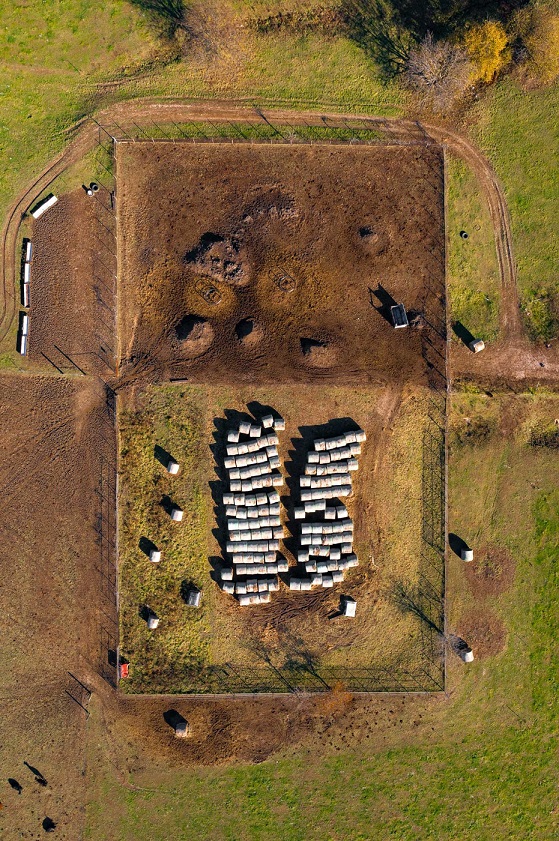
What research do you do?
Several things: Reading about the Cold War, going to Cold War museums and my own conversations with the land owners of the missile sites. There’s lots of using online maps, public property information and historic satellite images. Also studying the work of other photographers who share adjacent ideas or processes to help inform how I approach my own work.
Also noteworthy is that there is no formal photographic record yet for what any of this stuff looks like beyond Google Maps. So I’m hoping this effort is forging new ground.
Many can relate to growing up during the Cold War. What memorable response(s) have you had to your work?
I’ve had several people – around my age – see my work and tell me stories about how they felt growing up near these missile sites. Either spooked like I was or at least appreciating what was at stake. For example, when I approached the owner of Oscar-10 about her site, she had a fairly patriotic feeling about it but then also told me that as an adult looking back that “There were way more of these sites than anyone ever told us.” Alluding to the fact there were 150 of these in Missouri alone. Perhaps not widely known.
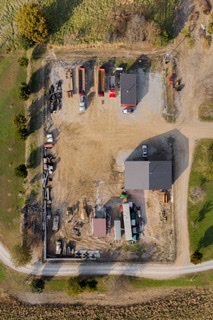
Is there a site that holds a special significance for you or is a favorite?
Each of these are special to me but my favorites are the ones that are the most overgrown or are today unrecognizable as what they once were because the passage of time is most evident. Those are the sites that remind us the loudest of what people have been able to do as far as deproliferation. They remind us there’s still time to avert disaster. Nuclear deals have worked. Arms reduction and deproliferation have worked. We’ve done it before, and so we can do it again. And we need to soon. And not just on nuclear weapons but all the existential fronts today: climate and disinformation.
What is your most important artist tool? Is there something you can’t live without in your studio?
Digital maps and my high-resolution drone camera. I mean up to about 2015 this work would not have even been possible without both of these. Even social media is so key because I can connect so much faster and easier with others who are interested in talking about this stuff.
What books, movies and/or music have inspired you recently?
The books that really inspired, focused, and changed me for the better are:
The Missile Next Door by Gretchen Heefner
The Doomsday Machine by Daniel Ellsberg
Command and Control by Eric Schlosser
Also the photography work of Terry Evans for her beautiful aerial landscape work.
And Richard Nickel’s photography for it’s focus on preserving Chicago’s historical architectural past
Music too. Really leaning into an ambient, contemplative vibe. I think this suits my state of mind when thinking about this stuff.
Mathijs Leeuis's Galibier (2018) is a young ambient composer and pedal steel guitarist
Luke Schneider’s Alter of Harmony (2020) is a very chill solo ambient instrumental pedal steel album
And William Tyler’s New Vanitas (2020) is another great instrumental moody vibe album
Podcasts:
There are some amazing podcasts that have been key for me in understanding arms control in our current events.
Arms control Wonk
Press the Button
Things That Go Boom
The Deal


